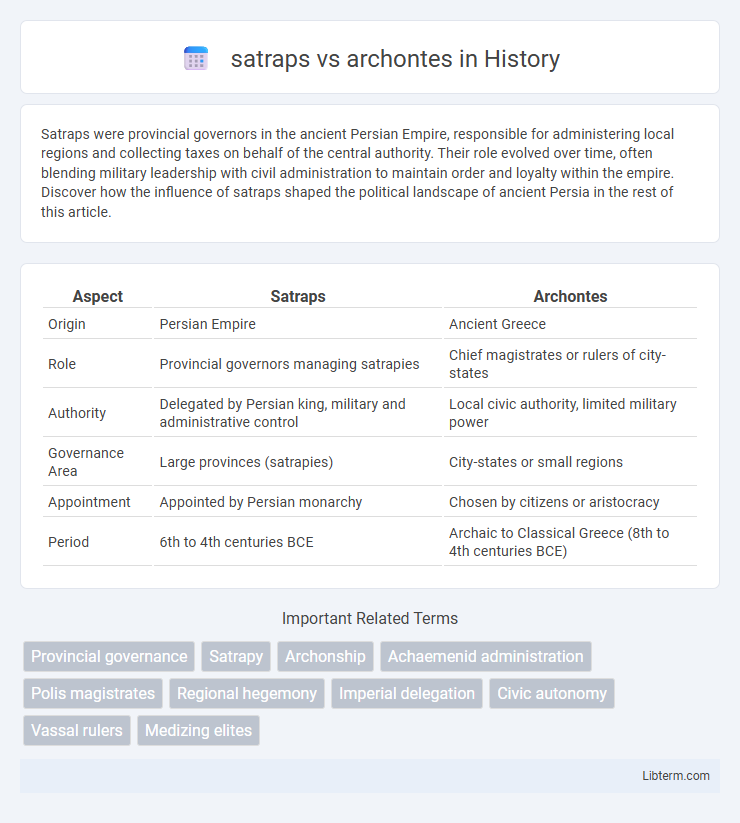Satraps were provincial governors in the ancient Persian Empire, responsible for administering local regions and collecting taxes on behalf of the central authority. Their role evolved over time, often blending military leadership with civil administration to maintain order and loyalty within the empire. Discover how the influence of satraps shaped the political landscape of ancient Persia in the rest of this article.
Table of Comparison
| Aspect | Satraps | Archontes |
|---|---|---|
| Origin | Persian Empire | Ancient Greece |
| Role | Provincial governors managing satrapies | Chief magistrates or rulers of city-states |
| Authority | Delegated by Persian king, military and administrative control | Local civic authority, limited military power |
| Governance Area | Large provinces (satrapies) | City-states or small regions |
| Appointment | Appointed by Persian monarchy | Chosen by citizens or aristocracy |
| Period | 6th to 4th centuries BCE | Archaic to Classical Greece (8th to 4th centuries BCE) |
Introduction: Defining Satraps and Archontes
Satraps were provincial governors in the ancient Persian Empire responsible for administering regions, collecting taxes, and maintaining order under the authority of the central king. Archontes were magistrates or rulers in ancient Greek city-states, often elected or appointed to oversee civic, military, and religious duties. Both roles exemplify administrative leadership but differ in political structure, with satraps operating within a centralized monarchy and archontes functioning in more localized, often democratic or oligarchic, systems.
Historical Origins of Satraps
Satraps originated in the Achaemenid Empire around the 6th century BCE as provincial governors overseeing vast territories, ensuring royal authority and tax collection. Archontes, primarily linked to ancient Greek city-states, functioned as elected magistrates with administrative and judicial duties but lacked the extensive territorial control characteristic of satraps. The satrapal system exemplified centralized imperial governance, contrasting with the more localized and often democratic nature of archontes in classical Greece.
Historical Origins of Archontes
Archontes originated in ancient Athens as chief magistrates who governed the city-state and held religious, military, and judicial responsibilities, with their institution dating back to the early 8th century BCE. Unlike satraps, who were provincial governors under the Achaemenid Persian Empire responsible for overseeing vast territories on behalf of the emperor, archontes typically administered city-level affairs within the Greek polis system. The historical development of archontes reflects the gradual shift from aristocratic rule to more structured civic governance in classical Athens.
Political Structure in Persia vs Greece
Satraps functioned as provincial governors within the centralized political structure of the Achaemenid Persian Empire, overseeing vast territories and ensuring the king's authority through administrative control and tax collection. Archontes, on the other hand, were elected magistrates in the decentralized city-states of ancient Greece, particularly Athens, where political power was distributed among citizens and local institutions rather than concentrated in a single ruler. This fundamental difference highlights Persia's hierarchical, autocratic governance compared to Greece's emerging democratic and oligarchic systems.
Roles and Responsibilities of Satraps
Satraps were provincial governors in the ancient Achaemenid Empire, responsible for tax collection, maintaining security, and overseeing administrative functions within their satrapy, ensuring loyalty to the central authority of the emperor. Unlike archontes, who typically governed city-states with more localized power and judicial duties, satraps held broader military command and were tasked with managing large regions. Their roles also included supervising local officials, reporting directly to the emperor, and sometimes leading troops during military campaigns to protect imperial interests.
Duties and Influence of Archontes
Archontes in ancient Greece held multifaceted roles, primarily overseeing religious ceremonies, legal judgments, and administrative governance within city-states. Unlike satraps, who acted as regional governors under Persian authority with military and fiscal responsibilities, archontes wielded influence by maintaining civic order and upholding local laws, significantly shaping political and social structures. Their duties often encompassed presiding over courts, organizing public festivals, and managing state archives, reflecting their integral position in sustaining Athenian democracy and cultural identity.
Selection and Appointment Processes
Satraps were appointed by Persian kings, often chosen from royal family members or loyal nobles to govern provinces (satrapies) and maintain centralized control. Archontes in ancient Greece, particularly Athens, were typically selected through a combination of election and lottery from eligible aristocratic families, reflecting a more localized and civic-based approach. The Persian system emphasized top-down imperial authority, while Greek archontic appointments underscored citizen participation and political rotation.
Power and Autonomy: Comparing Authority
Satraps, appointed by Persian emperors, held extensive regional power and administrative autonomy but remained subordinate to the central authority of the Achaemenid Empire. Archontes, governing city-states in ancient Greece, exercised localized authority with greater independence, often accountable to local assemblies or aristocracies. The key distinction lies in satraps' role as imperial representatives enforcing centralized control, while archontes operated within more decentralized governance systems allowing variable degrees of self-rule.
Legacy and Cultural Impact
Satraps, as provincial governors in the Achaemenid Empire, established administrative practices that influenced subsequent imperial governance systems, notably in Hellenistic and Roman territories. Archontes, ancient Greek magistrates, contributed significantly to the development of early democratic governance and civic organization, laying groundwork for Western political thought. The legacy of satraps is seen in centralized control and bureaucratic efficiency, while archontes impacted cultural traditions of civic participation and legal structures.
Conclusion: Key Differences and Similarities
Satraps were provincial governors in the Achaemenid Persian Empire, wielding military and administrative authority, while archontes were chief magistrates or rulers in various ancient Greek city-states, primarily focusing on civic leadership and judicial functions. Both roles involved governance but differed significantly in scope; satraps managed large territories and reported to the emperor, whereas archontes operated within autonomous city-states with elected or hereditary terms. Despite these differences, both satraps and archontes served as crucial intermediaries, maintaining control and stability within their respective political systems.
satraps Infographic

 libterm.com
libterm.com